Evaluating Synergies and Trade-Offs among Sustainable Development Goals (SDGs): Explorative Analyses of Development Paths in South Asia and Sub-Saharan Africa
Abstract
:1. Introduction
2. Methodology Framework and Data Sources
2.1. Network Analysis
2.2. Advanced Sustainability Analysis
3. Targets and Indicators to Monitor SDGs
4. Analysing Linkages among SDGs
4.1. SDG1 in Focus—Poverty Eradication
4.2. SDG2 in Focus—Ending Hunger and Guaranteeing Food Security
4.3. SDG6 in Focus—Water and Sanitation for All
4.4. SDG7 in Focus—Energy for All
4.5. Network of Various Targets within SDGs
- T-1.1
- Eradicate extreme poverty
- T-1.2
- Reduce the poverty by half in all its dimensions as per national definitions
- T-1.3
- Implement nationally appropriate social protection systems
- T-2.1
- End hunger and ensure universal access to nutritious and sufficient food
- T-2.2
- End all forms of malnutrition
- T-2.3
- Double the agricultural productivity and incomes of small-scale food producers
- T-2.4
- Ensure sustainable food production systems and increase productivity and production
- T-2.5
- Maintain the genetic diversity of seeds, cultivated plants, and farmed and domesticated animals
- T-6.1
- Achieve universal and equitable access to safe and affordable drinking water for all
- T-6.2
- Achieve access to adequate and equitable sanitation and hygiene for all
- T-6.3
- Improve water quality, halving the proportion of untreated wastewater, promote recycling and safe reuse
- T-6.4
- Substantially increase water-use efficiency across all sectors and substantially reduce the water scarcity
- T-7.1
- Ensure universal access to affordable, reliable, and modern energy services
- T-7.2
- Increase substantially the share of renewable energy in the global energy mix
- T-7.3
- Double the global rate of improvement in energy efficiency
5. Evaluation of Synergy and Trade-Off
5.1. Synergy among SDG7 and SDG1
5.2. Synergy among SDG7 and SDG2
5.3. Synergy between SDG7 and SDG6
6. Conclusions and Way Forward
Acknowledgments
Author Contributions
Conflicts of Interest
Appendix A
| Country_Year | T1.1 ii | T2.1 iii | T2.3 iii | T6.1 iv | T6.2 iv | T 6.4 iv | T7.1a i | T7.1b i |
|---|---|---|---|---|---|---|---|---|
| Bangladesh_1990 | 31.7 | 70.0 | 2490.6 | 72.2 | 36.5 | 1007.9 | 23.3 | 7.19 |
| Bangladesh_1995 | 42.3 | 74.3 | 2593.2 | 85.5 | 47.5 | 849.7 | 32.0 | 10.73 |
| Bangladesh_2000 | 54.3 | 103.6 | 3384.4 | 99.8 | 59.6 | 810.2 | 42.0 | 14.84 |
| Bangladesh_2005 | 70.1 | 118.5 | 3681.6 | 114.1 | 72.5 | 716.3 | 61.5 | 15.98 |
| Bangladesh_2010 | 86.0 | 125.6 | 4288.3 | 126.6 | 84.6 | 696.3 | 83.4 | 16.78 |
| Bangladesh_2012 | 92.8 | 128.5 | 4394.1 | 131.7 | 94.1 | 676.3 | 93.2 | 16.93 |
| Ethiopia_1990 | 13.3 | 8.0 | 1238.1 | 6.3 | 1.3 | 0.0 | 4.8 | 2.16 |
| Ethiopia_1995 | 20.9 | 16.6 | 1033.5 | 11.2 | 1.7 | 2003.5 | 6.6 | 3.01 |
| Ethiopia_2000 | 30.2 | 29.1 | 1116.3 | 19.2 | 5.7 | 1868.3 | 8.6 | 4.01 |
| Ethiopia_2005 | 41.6 | 41.8 | 1361.4 | 29.4 | 11.7 | 1508.2 | 11.5 | 3.38 |
| Ethiopia_2010 | 55.3 | 54.8 | 1832.8 | 41.9 | 19.0 | 1415.8 | 20.1 | 2.44 |
| Ethiopia_2012 | 61.5 | 60.2 | 2046.8 | 47.6 | 25.8 | 1323.3 | 24.9 | 2.02 |
| Ghana_1990 | 7.2 | 7.5 | 989.2 | 8.1 | 1.0 | 2103.1 | 4.5 | 0.29 |
| Ghana_1995 | 9.2 | 12.6 | 1354.1 | 10.6 | 1.4 | 1724.7 | 6.4 | 0.88 |
| Ghana_2000 | 11.5 | 15.7 | 1309.2 | 13.3 | 1.9 | 1627.9 | 8.5 | 1.60 |
| Ghana_2005 | 15.3 | 18.9 | 1432.3 | 16.5 | 2.6 | 1345.0 | 10.5 | 2.56 |
| Ghana_2010 | 19.9 | 22.7 | 1814.3 | 20.2 | 3.3 | 1265.6 | 14.8 | 3.76 |
| Ghana_2012 | 22.0 | 24.1 | 1768.1 | 21.8 | 3.8 | 1186.2 | 16.3 | 4.29 |
| Nepal_1990 | 4.1 | 14.5 | 1920.1 | 12.3 | 0.8 | 10685.7 | 2.8 | 4.17 |
| Nepal_1995 | 5.7 | 16.1 | 1891.3 | 15.2 | 2.8 | 8850.1 | 5.1 | 4.92 |
| Nepal_2000 | 7.6 | 18.5 | 2136.3 | 18.3 | 5.2 | 8467.1 | 7.8 | 5.71 |
| Nepal_2005 | 12.0 | 21.2 | 2311.6 | 21.0 | 7.6 | 7604.5 | 9.9 | 5.77 |
| Nepal_2010 | 20.5 | 24.1 | 2289.9 | 23.4 | 10.2 | 7405.8 | 13.2 | 5.68 |
| Nepal_2012 | 24.2 | 25.2 | 2714.2 | 24.4 | 12.6 | 7207.1 | 20.9 | 5.62 |
| Rwanda_1990 | 0.4 | 3.4 | 1042.6 | 4.2 | 2.4 | 1412.1 | 0.1 | 0.15 |
| Rwanda_1991 | 1.0 | 4.1 | 1145.3 | 4.8 | 3.1 | 1460.2 | 0.3 | 0.15 |
| Rwanda_2000 | 1.7 | 3.3 | 848.3 | 5.3 | 3.7 | 1286.4 | 0.5 | 0.16 |
| Rwanda_2005 | 2.5 | 4.6 | 1183.6 | 6.3 | 4.7 | 1002.0 | 0.7 | 0.18 |
| Rwanda_2010 | 3.8 | 6.2 | 1930.1 | 7.5 | 5.9 | 940.1 | 1.1 | 0.21 |
| Rwanda_2012 | 4.4 | 6.8 | 2169.5 | 8.0 | 6.7 | 878.2 | 1.9 | 0.22 |
| Sri Lanka_1990 | 14.5 | 11.7 | 2965.0 | 11.7 | 12.1 | 3122.3 | 13.3 | 2.06 |
| Sri Lanka_1995 | 15.0 | 12.2 | 3052.6 | 13.2 | 13.6 | 2881.6 | 14.2 | 2.95 |
| Sri Lanka_2000 | 16.0 | 13.1 | 3338.2 | 14.9 | 15.1 | 2834.8 | 15.1 | 3.91 |
| Sri Lanka_2005 | 18.0 | 13.5 | 3467.2 | 16.5 | 16.7 | 2684.6 | 16.1 | 4.47 |
| Sri Lanka_2010 | 19.3 | 14.7 | 3974.3 | 18.3 | 18.5 | 2634.9 | 17.7 | 5.07 |
| Sri Lanka_2012 | 19.8 | 15.2 | 3582.9 | 19.0 | 19.4 | 2585.2 | 19.2 | 5.29 |
- T-1.1
- Total number of people living on less than $1.25 a day (in millions)
- T-2.1
- Total number of people free from undernourishment (in millions)
- T-2.3
- Cereal yield (kg per Hectare)
- T-6.1
- Population using safely managed drinking water services (in millions)
- T-6.2
- Population using safely managed sanitation services (in millions)
- T-6.4
- Renewable internal freshwater resources (internal river flows and groundwater from rainfall) in the country (m3 per capita)
- T-7.1
- Population using: (i) reliable electricity; and (ii) clean cooking solutions in millions
| Region | 1990 | 1995 | 2000 | 2005 | 2010 | 2012 |
|---|---|---|---|---|---|---|
| Bangladesh | 105.98 | 118.63 | 131.28 | 142.93 | 151.62 | 155.26 |
| Ethiopia | 48.1 | 57.27 | 66.44 | 76.66 | 87.56 | 92.19 |
| Ghana | 14.63 | 16.725 | 18.82 | 21.39 | 24.3 | 25.54 |
| Nepal | 18.74 | 21.24 | 23.74 | 25.5 | 26.87 | 27.50 |
| Rwanda | 7.26 | 7.64 | 8.02 | 9 | 10.29 | 10.82 |
| Sri Lanka | 17.1 | 17.875 | 18.65 | 19.37 | 20.12 | 20.40 |
References
- Joshi, D.K.; Hughes, B.B.; Sisk, T.D. Improving Governance for the Post-2015 Sustainable Development Goals: Scenario Forecasting the Next 50 years. World Dev. 2015, 70, 286–302. [Google Scholar] [CrossRef]
- Hák, T.; Janousková, S.; Moldan, B. Sustainable Development Goals: A need for relevant indicators. Ecol. Indic. 2016, 60, 565–573. [Google Scholar] [CrossRef]
- Schmidt-Traub, G. Investment Needs to Achieve the Sustainable Development Goals: Understanding the Billions and Trillions; Working Paper; Sustainable Development Solutions Network (SDSN): New York, NY, USA, 2015. [Google Scholar]
- Weitz, N.; Nilsson, M.; Davis, M. A nexus approach to the post-2015 Agenda: Formulating integrated Water, Energy and Food SDGs. SAIS Rev. Int. Aff. 2014, 34, 37–50. [Google Scholar] [CrossRef]
- Waage, J.; Banerji, R.; Campbell, O.; Chirwa, E.; Collender, G.; Dieltiens, V.; Patcharanarumol, W. The Millennium Development Goals: A cross-sectoral analysis and principles for goal setting after 2015. Lancet and London International Development Centre Commission. Lancet 2010, 376, 991–1023. [Google Scholar] [CrossRef]
- Food and Agriculture Organization of the United Nations (FAO). The Water-Energy-Food Nexus: A New Approach in Support of Food Security and Sustainable Agriculture; FAO: Rome, Italy, 2014. [Google Scholar]
- World Economic Forum (WEF). Water Security: The Water-Food-Energy-Climate Nexus: The World Economic Forum Water Initiative; Waughray, D., Ed.; Island Press: Washington DC, USA, 2011. [Google Scholar]
- Hoff, H. Understanding the Nexus; Background Paper for the Bonn 2011 Conference: The Water, Energy and Food Security Nexus; Stockholm Environment Institute (SEI): Stockholm, Sweden, 2011. [Google Scholar]
- United States National Intelligence Council (US-NIC). Global Trends 2030: Alternative Worlds; United States National Intelligence Council: Washington DC, USA, 2012; p. 137.
- Endo, A.; Tsurita, I.; Kimberly, B.; Orencio, P.M. A review of the current state of research on the water, energy, and food nexus. J. Hydrol. Reg. Stud. 2017, 11, 20–30. [Google Scholar] [CrossRef]
- Food and Agriculture Organization of the United Nations (FAO). The State of the World’s Land and Water Resources for Food and Agriculture (SOLAW)—Managing Systems at Risk; FAO: Rome, Italy, 2011. [Google Scholar]
- Khan, E.U.; Mainali, B.; Martin, A.; Silveira, S. Techno-economic analysis of small scale biogas based poly-generation systems: Bangladesh case study. Sustain. Energy Technol. Assess. 2014, 7, 68–78. [Google Scholar] [CrossRef]
- Smajgl, A.; Ward, J.; Pluschke, L. The water–food–energy Nexus—Realizing a new paradigm. J. Hydrol. 2016, 533, 533–540. [Google Scholar] [CrossRef]
- Blanc, D.L. Towards Integration at Last? The Sustainable Development Goals as a Network of Targets; DESA Working Paper No. 141; United Nations Department of Economic and Social Affairs (UN DESA): New York, NY, USA, 2015. [Google Scholar]
- Luukkanen, J.; Vehmas, J.; Panula-Ontto, J.; Allievi, F.; Kaivo-oja, J.; Pasanen, T.; Auffermann, B. Synergies or Trade-offs? A new method to quantify synergy between different dimensions of sustainability. Environ. Policy Gov. 2012, 22, 337–349. [Google Scholar] [CrossRef]
- Halsnæs, K.; Garg, A. Assessing the Role of Energy in Development and Climate Policies—Conceptual Approach and Key Indicators. World Dev. 2011, 39, 987–1001. [Google Scholar] [CrossRef]
- Hicks, C.C.; Graham, N.A.J.; Cinner, J.E. Synergies and tradeoffs in how managers, scientists, and fishers value coral reef ecosystem services. Glob. Environ. Chang. 2013, 23, 1444–1453. [Google Scholar] [CrossRef]
- Duguma, L.A.; Wambugu, S.W.; Minang, P.A.; Van Noordwijk, M. A systematic analysis of enabling conditions for synergy between climate change mitigation and adaptation measures in developing countries. Environ. Sci. Policy 2014, 42, 138–148. [Google Scholar] [CrossRef]
- Landuyt, D.; Broekx, S.; Goethals, P.L.M. Unit Bayesian belief networks to analyse trade-offs among ecosystem services at the regional scale. Ecol. Indic. 2016, 71, 327–335. [Google Scholar] [CrossRef]
- Srivastava, P.; Hopwood, N. A Practical Iterative Framework for Qualitative Data Analysis. Int. J. Qual. Methods 2009, 8, 78–84. [Google Scholar] [CrossRef]
- Bruce, C.D. Questions arising about emergence, data collection, and its interaction with analysis in a grounded theory study. Int. J. Qual. Methods 2007, 6, 51–68. [Google Scholar] [CrossRef]
- Kaivo-oja, J.; Luukkanen, J.; Malaska, P. Advanced sustainability analysis. In Our Fragile World. Challenges and Opportunities for Sustainable Development. Encyclopedia of Life Support Systems and Sustainable Development; Tolba, M.K., Ed.; EOLSS Publishers Co. Ltd.: Oxford, UK, 2001; Volume 2, pp. 1529–1552. [Google Scholar]
- Kaivo-oja, J.; Luukkanen, J.; Malaska, P. Sustainability evaluation frameworks and alternative analytical scenarios of national economies. Popul. Environ. 2001, 23, 193–215. [Google Scholar] [CrossRef]
- Kaivo-oja, J.; Luukkanen, J. The European Union balancing between CO2 reduction commitments and growth policies. Energy Policy 2004, 32, 1511–1530. [Google Scholar] [CrossRef]
- Hoffrén, J.; Luukkanen, J.; Kaivo-oja, J. Decomposition analysis of Finnish material flows: 1960–1996. J. Ind. Ecol. 2001, 4, 105–125. [Google Scholar] [CrossRef]
- Luukkanen, J.; Kaivo-oja, J. ASEAN tigers and sustainability of energy use: Decomposition analysis of energy and CO2 efficiency dynamics. Energy Policy 2002, 30, 281–292. [Google Scholar] [CrossRef]
- Tapio, P.; Banister, D.; Luukkanen, J.; Vehmas, J.; Willamo, R. Energy and transport in comparison. Immaterialisation, dematerialisation and decarbonisation in the EU15 between 1970 and 2000. Energy Policy 2007, 35, 433–451. [Google Scholar] [CrossRef]
- Vehmas, J.; Luukkanen, J.; Kaivo-oja, J. Linking analyses and environmental Kuznets curves for aggregated material flows in the EU. J. Clean. Prod. 2007, 15, 1662–1673. [Google Scholar] [CrossRef]
- Kaivo-oja, J.; Vehmas, J.; Luukkanen, J. A Note: De-growth Debate and New Scientific Analysis of Economic Growth. J. Environ. Prot. 2014, 5, 1477–1481. [Google Scholar] [CrossRef]
- Southwood, K. Substantive Theory and statistical interaction: Five models. Am. J. Sociol. 1978, 83, 1154–1203. [Google Scholar] [CrossRef]
- Pachauri, S.; Cherp, A. Energy security and energy access: Distinct and interconnected challenges. Curr. Opin. Environ. Sustain. 2011, 3, 199–201. [Google Scholar] [CrossRef]
- Mainali, B.; Pachauri, S.; Rao, N.; Silveira, S. Assessing rural energy sustainability in developing countries. Energy Sustain. Dev. 2014, 19, 15–28. [Google Scholar] [CrossRef]
- World Bank Database. Sustainable Energy for All (SE4ALL) Database from World Bank, Global Electrification Database. 2016. Available online: http://data.worldbank.org/indicator/EG.ELC.ACCS.ZS (accessed on 6 July 2016).
- International Energy Agency (IEA). Access to Electricity Database, World Energy Outlook; IEA: Paris, France, 2015. [Google Scholar]
- Asian Development Bank (ADB). Assessment of Power Sector Reforms in Sri Lanka: Country Report; Asian Development Bank: Manila, Philippines, 2015. [Google Scholar]
- UN Database. Millennium Development Goals Database; United Nations Statistics Division: New York, NY, USA, 2016; Available online: http://data.un.org/Data.aspx?d=MDG&f=seriesRowID%3A580 (accessed on 10 June 2016).
- Bangladesh-HIES. Final Report of the Household Income and Expenditure Survey (HIES)-2010; Bangladesh Bureau of Statistics (BBS), Statistics Division, Ministry of Planning: Dhaka, Bangladesh, 2010.
- Development Planning and Research Directorate Ministry of Finance and Economic Development (MOFED)-Ethiopia. Ethiopia’s Progress towards Eradicating Poverty: An Interim Report on Poverty Analysis Study (2010/11); MOFED: Addis Ababa, Ethiopia, 2012.
- Ghana Statistical Service (GLSS)-Ghana. Poverty Profile in Ghana, Ghana Living Standard Survey Round 6; GLSS: Accra, Ghana, 2014. [Google Scholar]
- Food and Agriculture Organization Database (FAO Database). Food Security Indicators; Food and Agriculture Organization of United Nation: Rome, Italy, 2016; Available online: http://www.fao.org/economic/ess/ess-fs/ess-fadata/en/#.WIoBDU3JCow (accessed on 1 June 2016).
- WHO Database. Data on Water Supply and Sanitation; WHO/UNICEF Joint Monitoring Programme (JMP) for Water Supply and Sanitation; World Health Organization (WHO): Geneva, Switzerland, 2016. [Google Scholar]
- Loewe, M.; Rippin, N. Goal 1: End Poverty in All Its Forms Everywhere. Translating an Ambitious Vision into Global Transformation: The 2030 Agenda for Sustainable Development; Loewe, M., Rippin, N., Eds.; Discussion Paper; German Development Institute (DIE), Department “Sustainable Economic and Social Development”: Bonn, Germany, 2015. [Google Scholar]
- International Council for Science/International Social Science Council (ICSU/ISSC). Review of the Sustainable Development Goals: The Science Perspective; ICSU: Paris, France, 2015. [Google Scholar]
- Burchi, F.; Holzapfel, S. Goal 2: End Hunger, Achieve Food Security and Improved Nutrition, and Promote Sustainable Agriculture. Translating an Ambitious Vision into Global Transformation: The 2030 Agenda for Sustainable Development; Loewe, M., Rippin, N., Eds.; Discussion Paper; German Development Institute (DIE), Department “Sustainable Economic and Social Development”: Bonn, Germany, 2015. [Google Scholar]
- UN/SDGs. Sustainable Development Goals (SDGs). 17 Goals to Transform Our World. 2016. Available online: http://www.un.org/sustainabledevelopment/sustainable-development-goals/ (accessed on 12 October 2016).
- Food and Agriculture Organization (FAO). FAO and 17 Sustainable Development Goals; Food and Agriculture Organization (FAO) of the United Nations: Rome, Italy, 2015. [Google Scholar]
- Khandker, S.R.; Barnes, D.F.; Samad, H.A. The Welfare Impacts of Rural Electrification in Bangladesh. Energy J. 2012, 33, 187–206. [Google Scholar] [CrossRef]
- Yadoo, A.; Cruickshank, H. The role for low carbon electrification technologies in poverty reduction and climate change strategies: A focus on renewable energy mini-grids with case studies in Nepal, Peru and Kenya. Energy Policy 2012, 42, 591–602. [Google Scholar] [CrossRef]
- Gomez, M.; Silveira, S. Rural electrification of the Brazilian Amazon–Achievements and lessons. Energy Policy 2010, 38, 6251–6260. [Google Scholar] [CrossRef]
- Lenz, L.; Munyehirwe, A.; Peters, J.; Sievert, M. Does Large-Scale Infrastructure Investment Alleviate Poverty? Impacts of Rwanda’s Electricity Access Roll-Out Program. World Dev. 2017, 89, 88–110. [Google Scholar] [CrossRef]
- Diaz-Chavez, R.; Johnson, F.X.; Richard, T.L.; Chanakyad, H. Biomass Resources, Energy Access and Poverty Reduction (Chapter 21) within Bioenergy and Sustainability; World Bank: Washington, DC, USA, 2015. [Google Scholar]
- WHO/UNICEF. Progress on Sanitation and Drinking Water—2015 Update and MDG Assessment; Food and Agriculture Organization (FAO) of the United Nations: Rome, Italy, 2015. [Google Scholar]
- United Nations Development Programme (UNDP). Human Development Report 2006: Beyond Scarcity—Power, Poverty and the Global Water Crisis; UNDP: New York, NY, USA, 2006. [Google Scholar]
- Pories, L. Income-enabling, not consumptive: Association of household socioeconomic conditions with safe water and sanitation. Aquat. Procedia 2016, 6, 74–86. [Google Scholar] [CrossRef]
- Asian Development Bank (ADB). Sri Lanka’s Water Supply and Sanitation Sector: Achievements and a Way Forward; ADB South Asia Working Paper Series; ADB: Manila, Philippines, 2015. [Google Scholar]
- Christiaensen, L.; Demery, L.; Kuhl, J. The (evolving) role of agriculture in poverty reduction—An empirical perspective. J. Dev. Econ. 2011, 96, 239–254. [Google Scholar] [CrossRef]
- Klasen, S.; Reimers, M. Looking at Pro-Poor Growth from an Agricultural Perspective. World Dev. 2016, 90, 147–168. [Google Scholar] [CrossRef]
- Food and Agriculture Organization (FAO). The State of Food Insecurity in the World: Addressing Food Insecurity in Protracted Crises; FAO: Rome, Italy, 2010. [Google Scholar]
- Conceição, P.; Levine, S.; Lipton, M.; Rodríguez, A.W. Toward a food secure future: Ensuring food security for sustainable human development in Sub-Saharan Africa. Food Policy 2016, 60, 1–9. [Google Scholar] [CrossRef]
- Rasul, G. Food, water, and energy security in South Asia: A nexus perspective from the Hindu Kush Himalayan region. Environ. Sci. Policy 2014, 39, 35–48. [Google Scholar] [CrossRef]
- FAO-AQUASTAT. Main Database, Food and Agriculture Organization of the United Nations (FAO). 2016. Available online: http://www.fao.org/nr/water/aquastat/data/query/index.html?lang=en (accessed on 15 July 2016).
- Food and Agriculture Organization Corporate Statistical Database (FAOSTAT). Energy Use in Agriculture and Forestry; FAOSTAT: Rome, Italy, 2016; Available online: http://www.fao.org/faostat/en/#data/EE (accessed on 15 July 2016).
- Asian Development Bank (ADB). Food Security and Poverty in Asia and the Pacific: Key Challenges and Policy Issues; ADB: Manila, Philippines, 2012. [Google Scholar]
- Dombrowsky, I. Ensure Availability and Sustainable Management of Water and Sanitation for All, A Discussion Paper on Translating an Ambitious Vision into Global Transformation: The 2030 Agenda for Sustainable Development; Loewe, M., Rippin, N., Eds.; Deutsches Institut für Entwicklungspolitik: Bonn, Germany, 2015. [Google Scholar]
- Mugagga, F.; Nabaasa, B.B. The centrality of water resources to the realization of Sustainable Development Goals (SDG). A review of potentials and constraints on the African continent. Int. Soil Water Conserv. Res. 2016, 4, 215–223. [Google Scholar] [CrossRef]
- Freitas, A. Water as a Stress Factor in Sub-Saharan Africa; European Union Institute for Security Studies: Paris, France, 2013; Available online: http://www.iss.europa.eu/uploads/media/Brief_12.pdf (accessed on 7 March 2018).
- Intergovernmental Panel on Climate Change (IPCC). Climate Change 2014. Synthesis Report: Approved Summary for Policy Makers. IPCC Fifth Assessment Synthesis Report, 2014. Available online: http://www. ipcc.ch/ (accessed on 7 March 2018).
- World Water Assessment Programme (WWAP). The United Nations World Water Development Report 2015. Water for a Sustainable World; UNESCO: Paris, France, 2015. [Google Scholar]
- Global Energy Assessment (GEA). Global Energy Assessment: Toward a Sustainable Future; Cambridge University Press: Cambridge, UK; New York, NY, USA; The International Institute for Applied Systems Analysis: Laxenburg, Austria, 2012. [Google Scholar]
- The International Renewable Energy Agency (IRENA). Renewable Energy in the Water, Energy and Food Nexus; IRENA: Laxenburg, Austria, 2015. [Google Scholar]
- Biswas, W.K. Application of renewable energy to provide safe water from deep tube wells in rural Bangladesh. Energy Sustain. Dev. 2011, 15, 55–60. [Google Scholar] [CrossRef]
- Mainali, B. Renewable Energy Market for Rural Electrification in Developing Countries: Country Case Nepal. Licentiate Thesis, Royal Institute of Technology KTH School of Industrial Engineering and Management, Stockholm, Sweden, 2011. [Google Scholar]
- Barnes, D.; Halpern, J. Reaching the poor: Designing energy subsidies to benefit those that need it. Refocus 2001, 2, 32–34. [Google Scholar] [CrossRef]
- International Energy Agency (IEA). Water for Energy: Is Energy Becoming a Thirstier Resource? Chapter 17. Excerpt from the World Energy Outlook 2012; IEA: Paris, France, 2012. [Google Scholar]
- International Hydropower Association (IHA). Hydropower Status Report; IHA Central Office: London, UK, 2016. [Google Scholar]
- Zhang, L.; Yang, Z.; Chen, B.; Chen, G. Rural energy in China: Pattern and policy. Renew. Energy 2009, 34, 2813–2823. [Google Scholar] [CrossRef]
- Mukaka, M.M. Statistics Corner: A guide to appropriate use of Correlation coefficient in medical research. Malawi Med. J. 2012, 24, 69–71. [Google Scholar] [PubMed]
- Sustainable Energy for All Acceleration Framework-Ghan (SE4ALL-Ghana). Situational Analysis Report; SE4ALL: Abidjan, Ghana, 2012. [Google Scholar]
- Sustainable Energy for All Acceleration Framework-Ghan (SE4ALL-Ghana). Medium Term National Development Policy Framework Ghana, Ghana Shared Growth and Development Agenda (GSGDA), 2010–2013; Government of Ghana: Accra, Ghana, 2010.
- Barki, E.; Parente, J. Challenges and Opportunities of the Last Mile for the Base of the Pyramid: The Case of Brazil. Field Actions Science Reports [Online] 2014, Special Issue 12. Online Since 21 October 2014, Connection on 14 November 2016. 2014. Available online: http://factsreports.revues.org/3671 (accessed on 7 March 2018).
- Mainali, B.; Silveira, S. Renewable Energy Market in Rural Electrification: Country Case Nepal. Energy Sustain. Dev. 2012, 16, 168–178. [Google Scholar] [CrossRef]
- Mainali, B.; Silveira, S. Alternative pathways for providing access to electricity in developing countries. Renew. Energy 2013, 57, 299–310. [Google Scholar] [CrossRef]
- Thapa, S.; Acharya, S. Remittances and Household Expenditure in Nepal: Evidence from Cross-Section Data. Economies 2017, 5, 16. [Google Scholar] [CrossRef]
- Dahal, P. The impact of remittances on economic growth in Nepal: An analysis of a significant basis of development. Asia Pac. J. Public Adm. 2014, 36, 261–282. [Google Scholar] [CrossRef]
- Mainali, B.; Silveira, S. Financing off-grid rural electrification: Country case Nepal. Energy 2011, 36, 2194–2201. [Google Scholar] [CrossRef]
- Bhattacharyya, S.C.; Palit, D. Mini-grid based off-grid electrification to enhance electricity access in developing countries: What policies may be required? Energy Policy 2016, 94, 166–178. [Google Scholar] [CrossRef] [Green Version]
- Sarangi, G.K.; Pugazenthi, D.; Mishra, A.; Palit, D.; Kishore, V.V.N.; Bhattacharyya, S.C. Poverty amidst plenty: Case of renewable energy-based off-grid electrification in Nepal. In Mini-Grids for Rural Electrification of Developing Countries, Green Energy and Technology; Bhattacharyya, S.C., Palit, D., Eds.; Springer International Publishing: Cham, Switzerland, 2014. [Google Scholar]
- Gurung, A.; Oh, S.E. Conversion of traditional biomass into modern bioenergy systems: A review in context to improve the energy situation in Nepal. Renew. Energy 2013, 50, 206–213. [Google Scholar] [CrossRef]
- Heringtona, M.J.; Malakara, Y. Who is energy poor? Revisiting energy (in) security in the case of Nepal. Energy Res. Soc. Sci. 2016, 21, 49–53. [Google Scholar] [CrossRef]
- Ministry of Environment (MOE)-Nepal. Rural Energy Policy Nepal; Ministry of Environment: Kathmandu, Nepal, 2006.
- Rahut, D.B.; Behera, B.; Ali, A. Patterns and determinants of household use of fuels for cooking: Empirical evidence from sub-Saharan Africa. Energy 2016, 117, 93–104. [Google Scholar] [CrossRef]
- Tessema, Z.; Mainali, B.; Silveira, S. Mainstreaming and Sector wide approaches to sustainable energy access in Ethiopia. Energy Strategy Rev. 2014, 2, 313–322. [Google Scholar] [CrossRef]
- Behera, B.; Rahut, D.B.; Aryal, J.; Ali, A. Household collection and use of biomass energy sources in South Asia. Energy 2015, 85, 468–480. [Google Scholar] [CrossRef]
- Nicolai, S.; Hoy, C.; Bhatkal, T.; Aedy, T. Projecting Progress: The SDGs in Sub-Saharan Africa; Overseas Development Institute: London, UK, 2016. [Google Scholar]
- Ministry of Food and Agriculture (MoFA)-Ghana. Food and Agriculture Sector Development Policy (FASDEP II); MoFA: Accra, Ghana, 2007.
- Ministry of Food and Agriculture (MoFA)-Ghana. Ministry of Food and Agriculture: Pilot Program Based Budget (PBB) for 2013–2015; MoFA: Accra, Ghana, 2012.
- Adom, P.K. Determinants of food availability and access in Ghana: What can we learn beyond the regression results? Stud. Agric. Econ. 2014, 116, 153–164. [Google Scholar] [CrossRef]
- FAO, IFAD and WFP. The State of Food Insecurity in the World 2015. In Proceedings of the Meeting of the 2015 International Hunger Targets: Taking Stock of Uneven Progress, Rome, Italy, 16 September 2015; FAO: Rome, Italy, 2015. [Google Scholar]
- Ministry of Water Resources, Works and Housing (MoWRWaH)-Ghana. National Water Policy. Ministry of Water Resources, Works and Housing; Government of Ghana: Accra, Ghana, 2007.
- Ministry of Water Resources, Works and Housing (MoWRWaH)-Ghana. Water Sector Strategic Development Plan (2012–2025); MoWRWaH: Accra, Ghana, 2014.
- Ministry of Water Supply & Drainage (MoWSD)-Sri-Lanka. National Water Supply and Sanitation-2002; MoWSD: Nawala, Sri-Lanka, 2002.
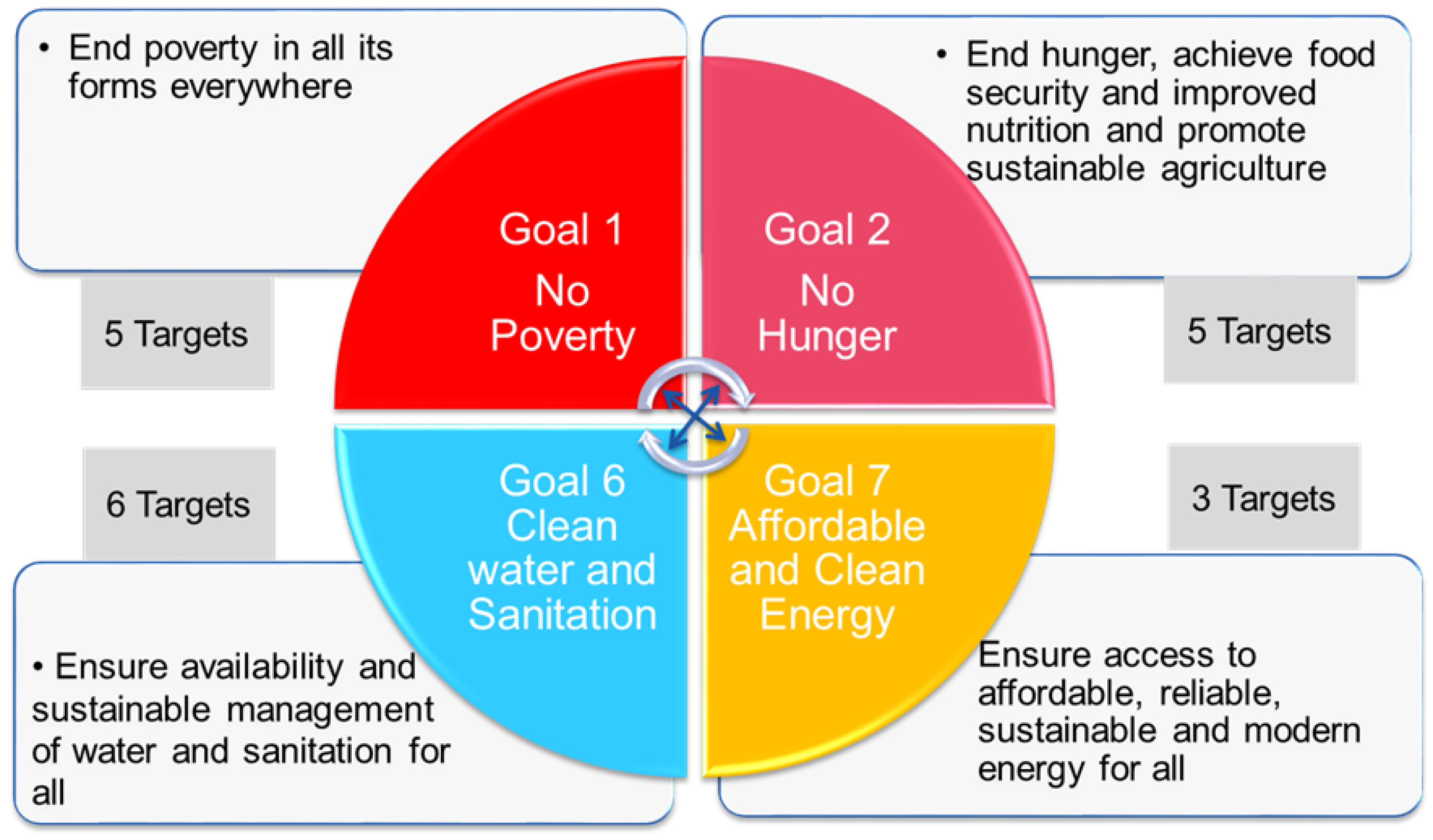

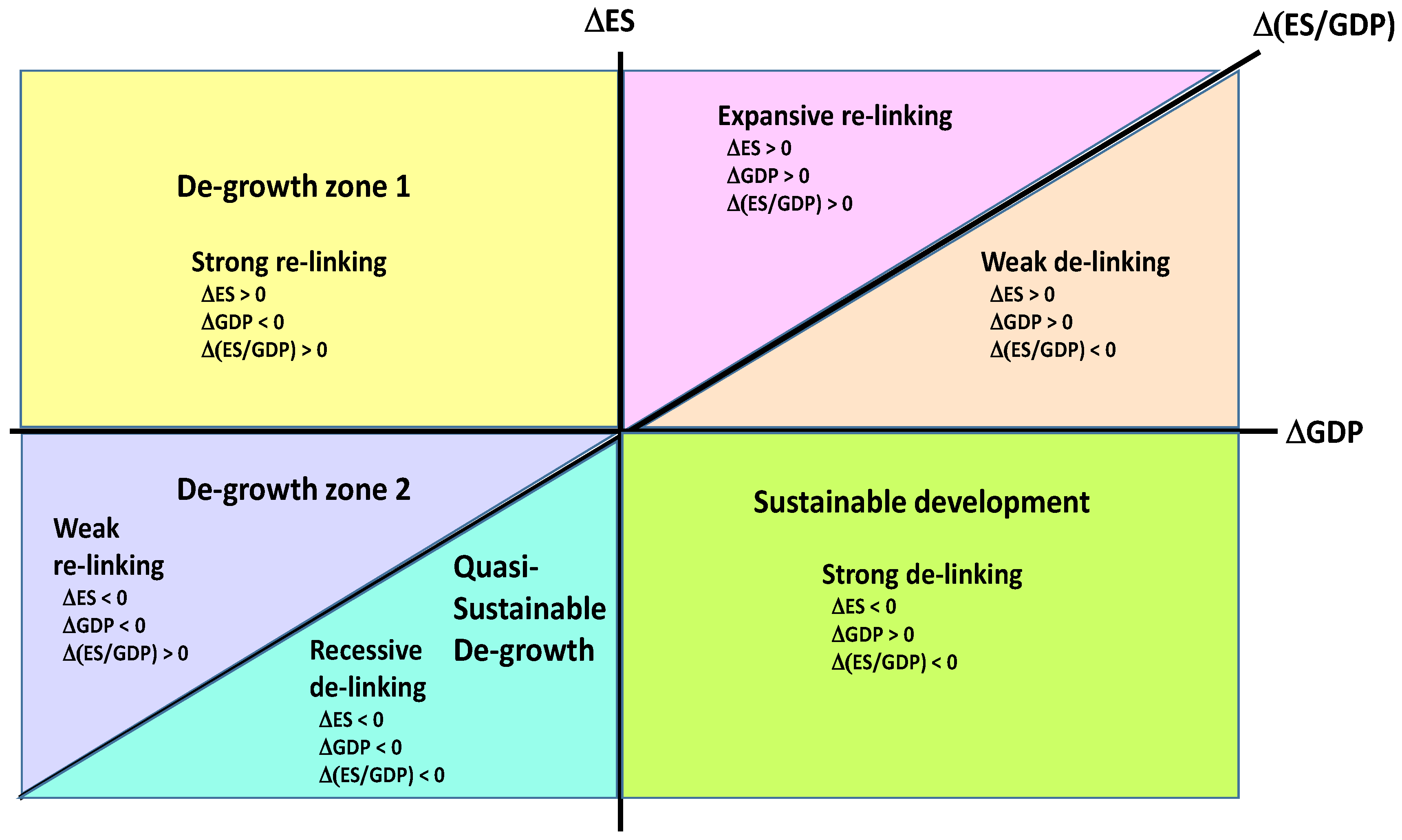
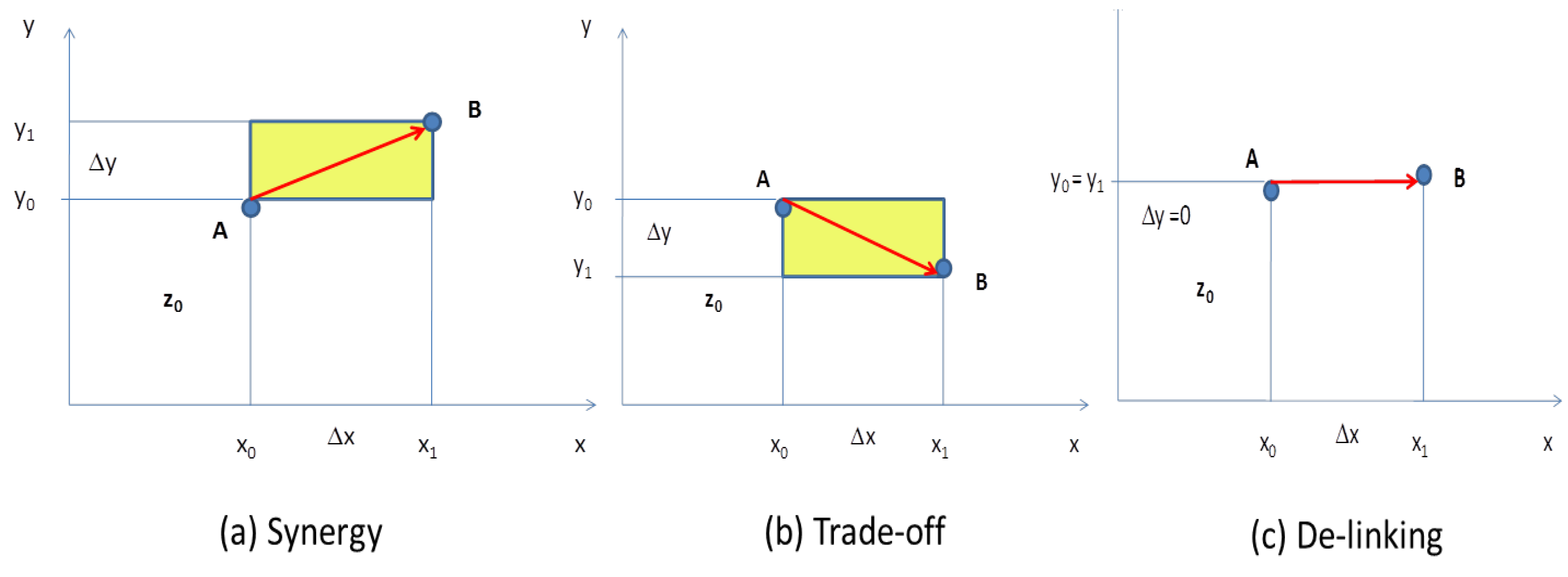
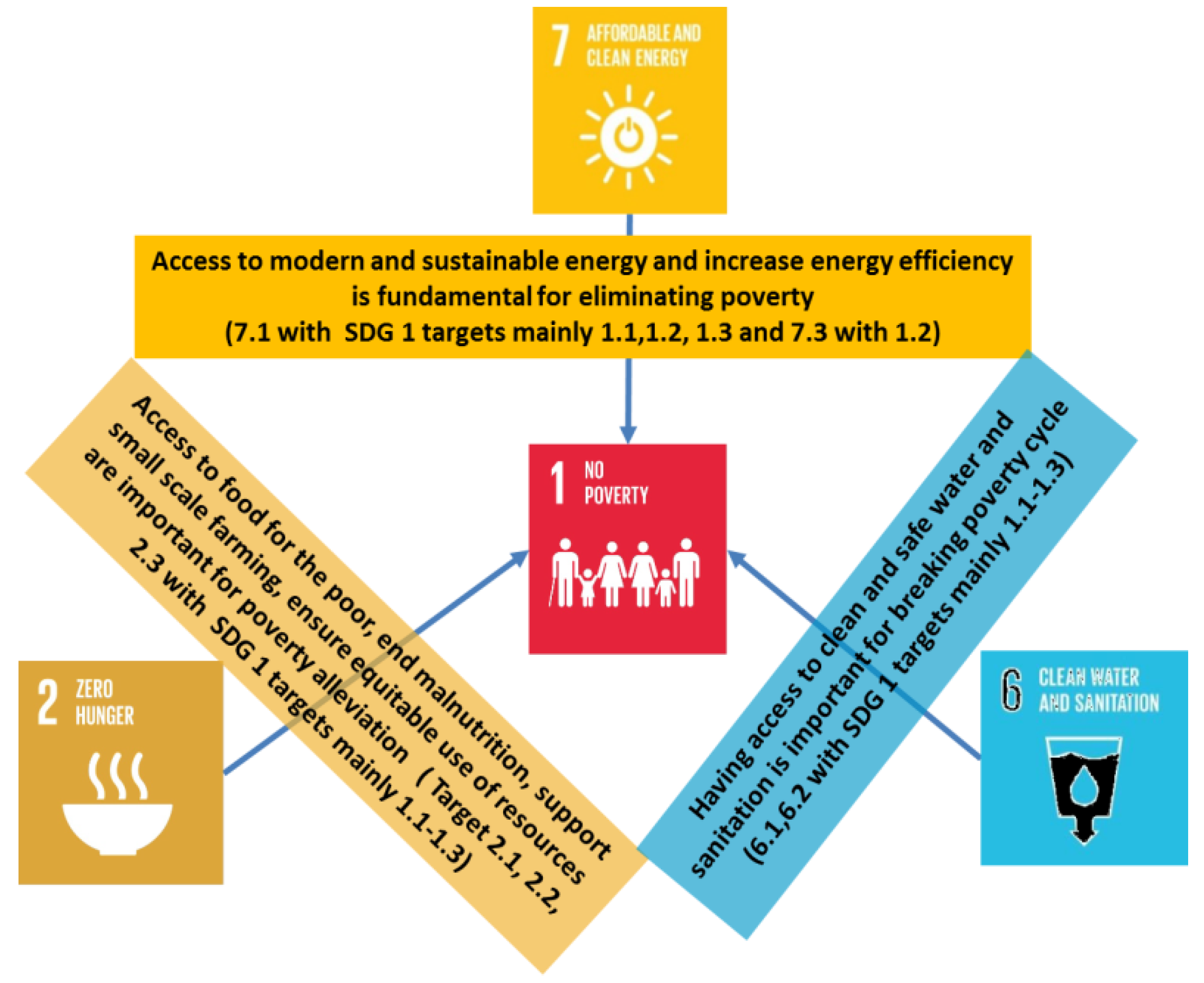
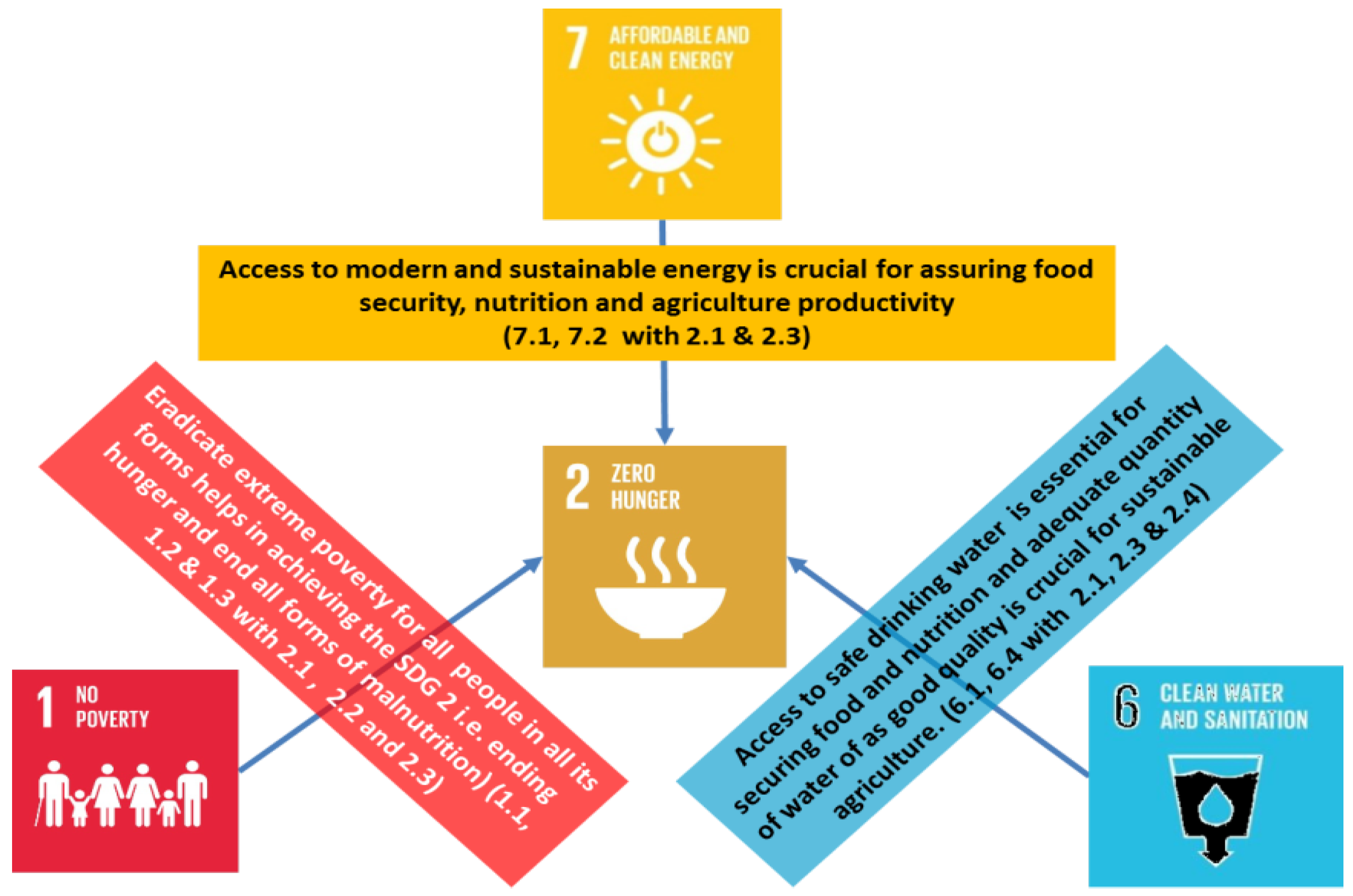
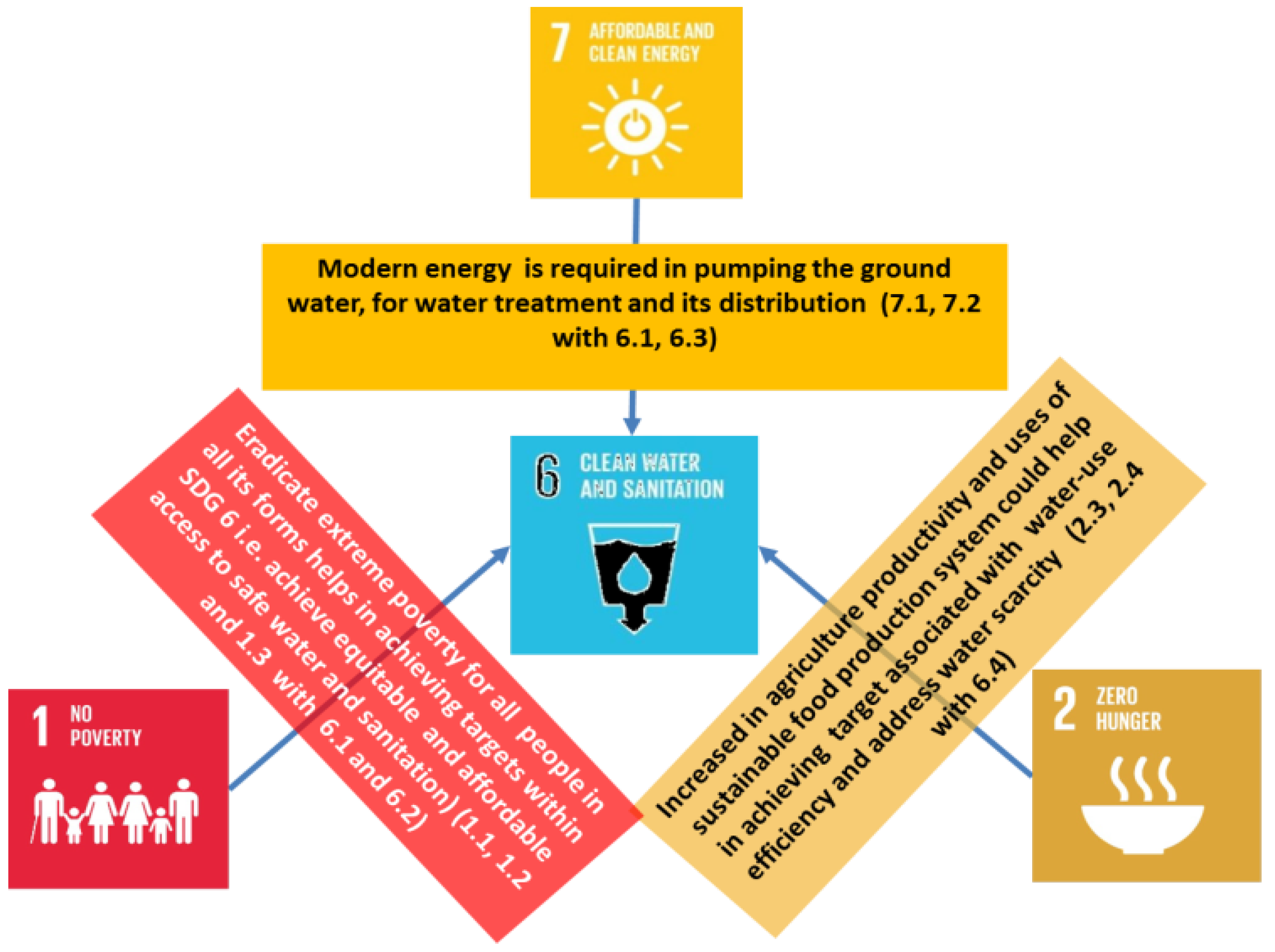
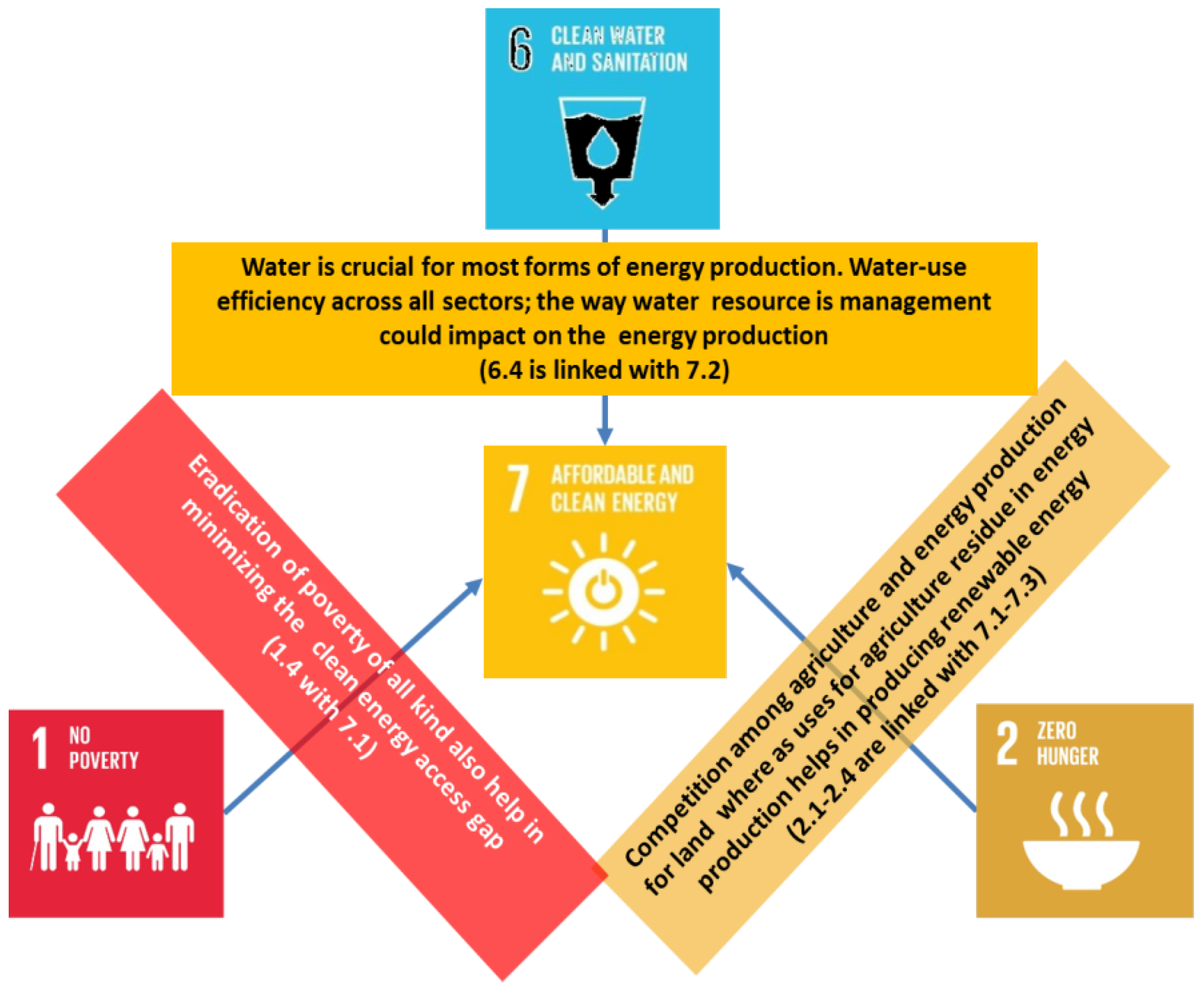
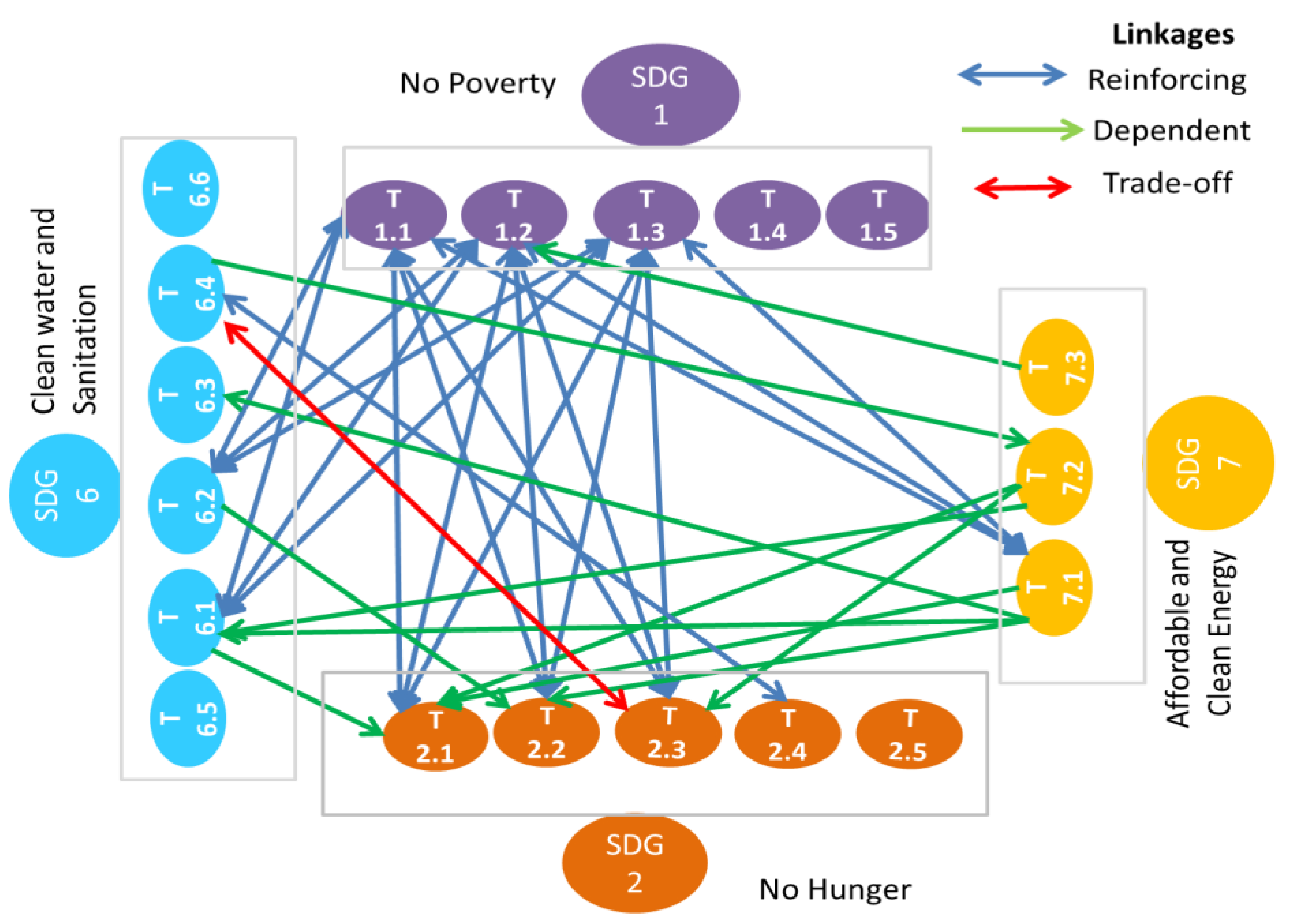

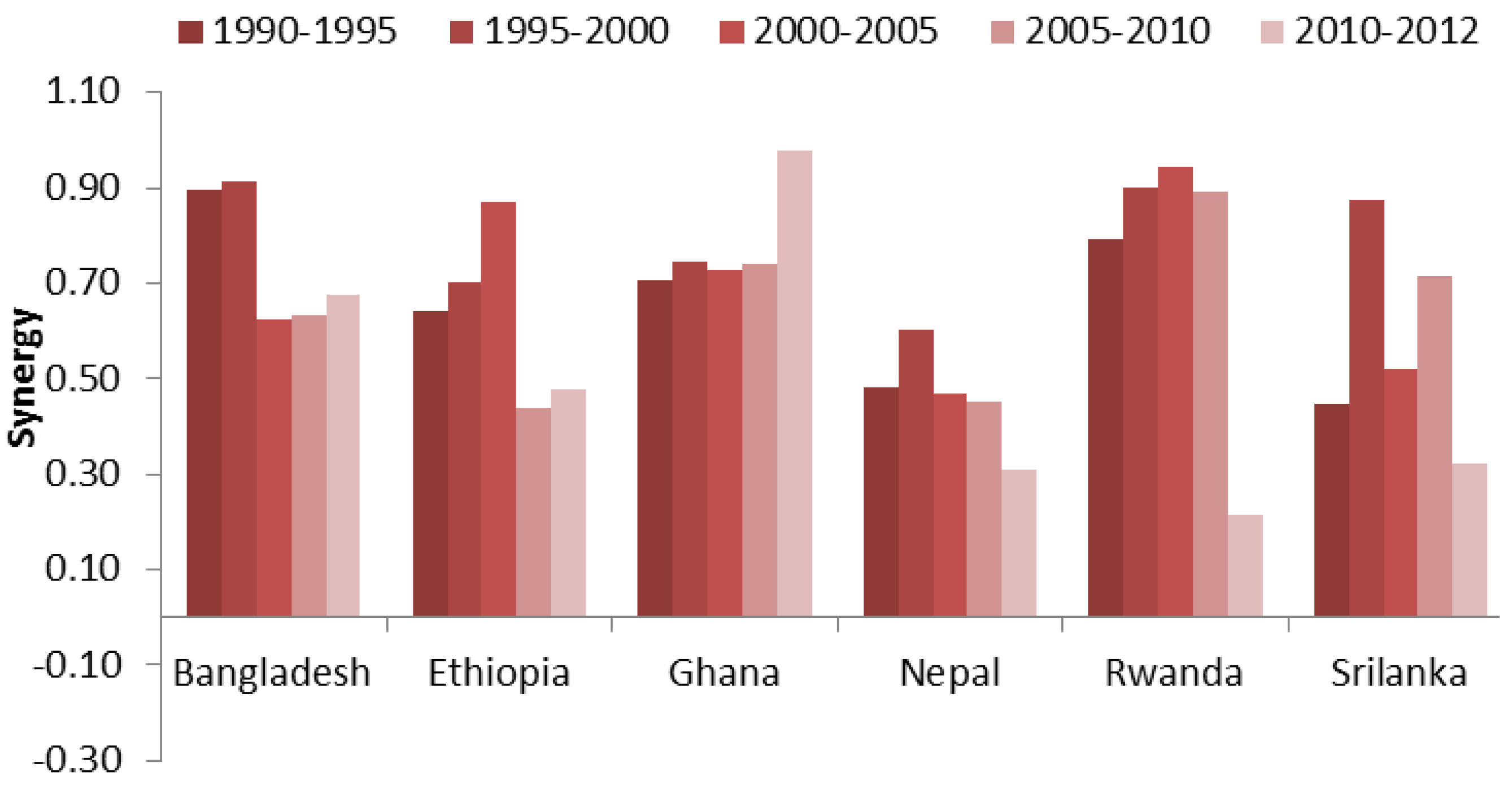

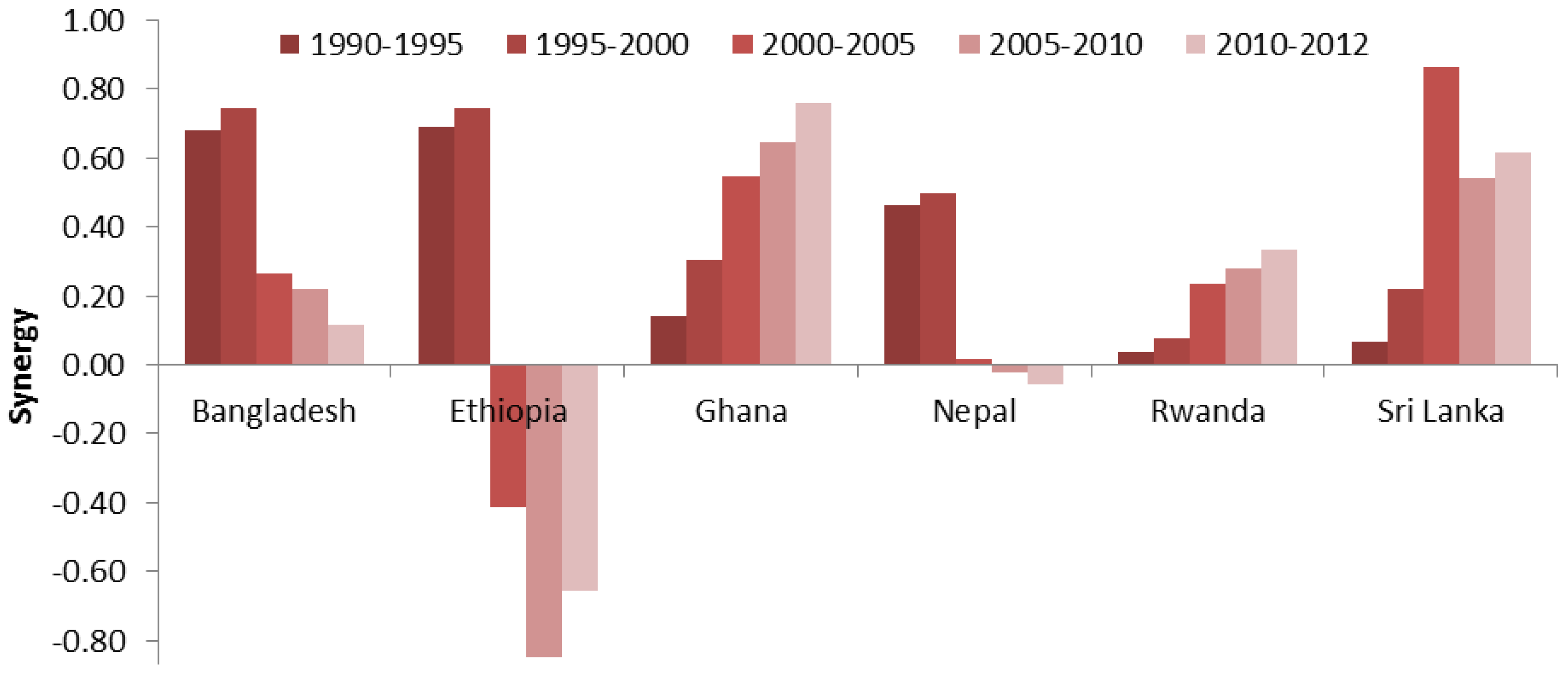

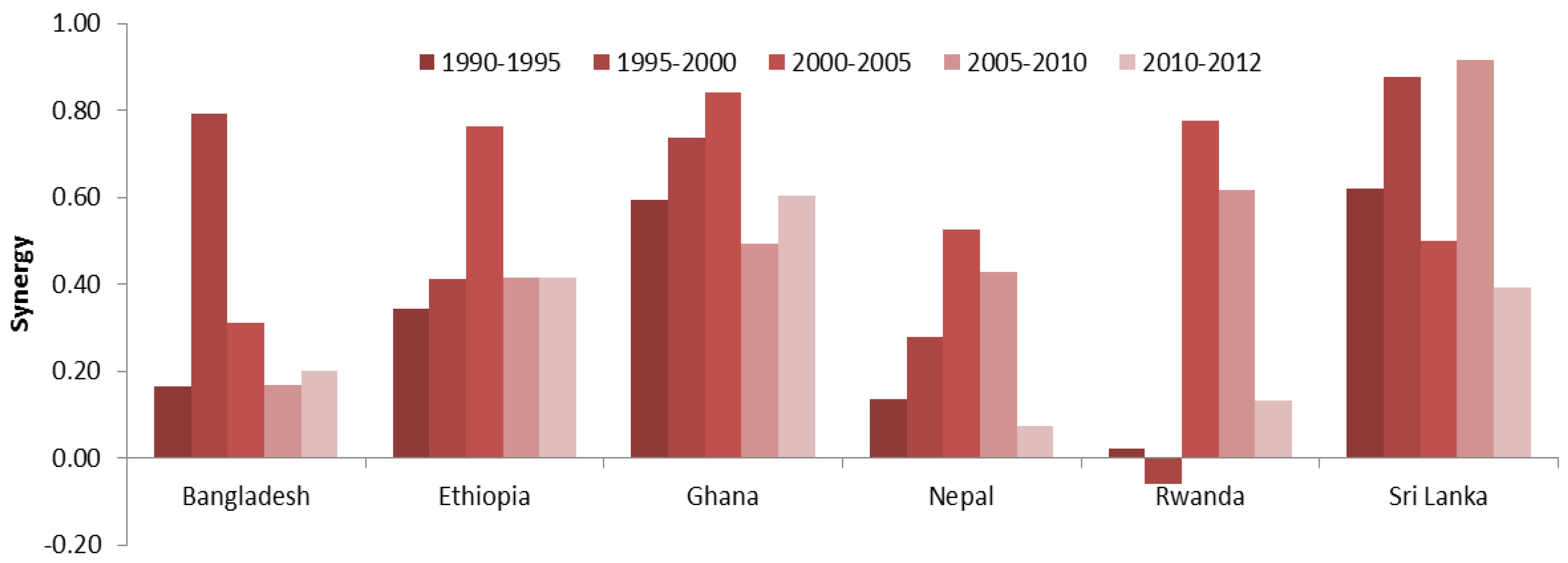


| SDGs | Sym | Targets Description | Measuring/Tracking Indicators |
|---|---|---|---|
| End poverty on all its form everywhere | T-1.1 | By 2030, eradicate extreme poverty for all people | Numbers of people living on less than $1.25 a day |
| T-1.2 | By 2030, reduce the poverty by half in all its dimensions according to national definitions | Population living below national poverty line | |
| T-1.3 | Implement nationally appropriate social protection systems and achieve substantial coverage by 2030 | Multidimensional poverty index, population covered by national social protection programs | |
| End hunger, achieve food security and improved nutrition and promote sustainable agriculture | T-2.1 | By 2030, end hunger and ensure universal access to nutritious and sufficient food | Population below minimum level of dietary energy consumption (undernourished) |
| T-2.2 | By 2030, end all forms of malnutrition, including achieving, by 2025, the internationally agreed targets on stunting and wasting in children under 5 years of age | Per cent of women of reproductive age (15–49) with anaemia Prevalence of stunting and wasting in children under 5 years of age | |
| T-2.3 | By 2030, double the agricultural productivity and incomes of small-scale food producers | Crop yield or livestock yield Number of agricultural extension workers per 1000 farmers | |
| T-2.4 | By 2030, ensure sustainable food production systems and implement resilient agricultural practices that increase productivity and production | Losses from natural disasters, by climate and non-climate-related events (in US$ and lives lost) | |
| T-2.5 | By 2020, maintain the genetic diversity of seeds, cultivated plants, farmed and domesticated animals, and their related wild species | (Indicator on genetic diversity in agriculture)—not yet developed | |
| Ensure availability and sustainable management of water and sanitation for all | T-6.1 | By 2030, achieve universal and equitable access to safe and affordable drinking water for all | Household or percentage of population using safely managed drinking water services |
| T-6.2 | By 2030, achieve access to adequate and equitable sanitation and hygiene for all | Percentage of population using safely managed sanitation services | |
| T-6.3 | By 2030, improve water quality by reducing pollution, halving the proportion of untreated wastewater and increasing substantially by recycling and safe reuse | Percentage of wastewater safely treated, ratio of treated waste water, directly used treated water to total produced municipal waste water | |
| T-6.4 | By 2030, substantially increase water-use efficiency across all sectors and substantially reduce the water scarcity | Level of water stress: Renewable internal freshwater resources (internal river flows and groundwater from rainfall) in the country m3 per capita | |
| Ensure access to affordable, reliable, sustainable and modern energy for all | T-7.1 | By 2030, ensure universal access to affordable, reliable, and modern energy services | Share of the population using: (i) reliable electricity; and (ii) modern cooking solutions in per cent |
| T-7.2 | Increase substantially the share of renewable energy in the global energy mix by 2030 | Share of renewable energy in total primary energy or electricity consumption | |
| T-7.3 | Double the global rate of improvement in energy efficiency by 2030 | Rate of primary energy intensity improvement |
| Indicators | SDG_T1.2 | SDG_T2.1 | SDG_T2.3 | SDG_T6.1 | SDG_T6.2 | SDG_T6.4 | SDG_T7.1 |
|---|---|---|---|---|---|---|---|
| SDG_T1.2 | 1 | 0.94 *** | 0.58 ** | 0.91 *** | 0.89 *** | −0.32 * | 0.92 *** |
| SDG_T2.1 | 0.94 *** | 1 | 0.59 ** | 0.99 *** | 0.95 *** | −0.27 ns | 0.93 *** |
| SDG_T2.3 | 0.58 ** | 0.59 ** | 1 | 0.64 *** | 0.75 *** | 0.02 ns | 0.74 *** |
| SDG_T6.1 | 0.91 *** | 0.99 *** | 0.64 *** | 1 | 0.97 *** | −0.27 ns | 0.94 *** |
| SDG_T6.2 | 0.89 *** | 0.95 *** | 0.75 *** | 0.97 *** | 1 | −0.3 * | 0.97 *** |
| SDG_T6.4 | −0.32 * | −0.27 ns | 0.02 ns | −0.27 ns | −0.3 * | 1 | −0.25 ns |
| SDG_T7.1 | 0.92 *** | 0.93 *** | 0.74 *** | 0.94 *** | 0.97 *** | −0.25 ns | 1 |
© 2018 by the authors. Licensee MDPI, Basel, Switzerland. This article is an open access article distributed under the terms and conditions of the Creative Commons Attribution (CC BY) license (http://creativecommons.org/licenses/by/4.0/).
Share and Cite
Mainali, B.; Luukkanen, J.; Silveira, S.; Kaivo-oja, J. Evaluating Synergies and Trade-Offs among Sustainable Development Goals (SDGs): Explorative Analyses of Development Paths in South Asia and Sub-Saharan Africa. Sustainability 2018, 10, 815. https://doi.org/10.3390/su10030815
Mainali B, Luukkanen J, Silveira S, Kaivo-oja J. Evaluating Synergies and Trade-Offs among Sustainable Development Goals (SDGs): Explorative Analyses of Development Paths in South Asia and Sub-Saharan Africa. Sustainability. 2018; 10(3):815. https://doi.org/10.3390/su10030815
Chicago/Turabian StyleMainali, Brijesh, Jyrki Luukkanen, Semida Silveira, and Jari Kaivo-oja. 2018. "Evaluating Synergies and Trade-Offs among Sustainable Development Goals (SDGs): Explorative Analyses of Development Paths in South Asia and Sub-Saharan Africa" Sustainability 10, no. 3: 815. https://doi.org/10.3390/su10030815
APA StyleMainali, B., Luukkanen, J., Silveira, S., & Kaivo-oja, J. (2018). Evaluating Synergies and Trade-Offs among Sustainable Development Goals (SDGs): Explorative Analyses of Development Paths in South Asia and Sub-Saharan Africa. Sustainability, 10(3), 815. https://doi.org/10.3390/su10030815








